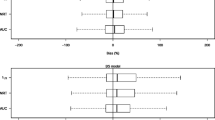Abstract
Purpose. Pharmacokinetic (PK) studies assume that the tracer's PK is equivalent to the parent compound. This assumption is often violated. The aim of this work is to present a method enabling the ideal tracer PK, i.e. the PK of the parent compound, to be predicted from the non-ideal tracer.
Methods. The procedure uses a disposition decomposition-recomposition (DDR) that assumes that the labeling mainly changes the elimination kinetics while the distribution kinetics is not significantly affected. In the DDR procedure an elimination rate constant correction factor (kCOR) is determined from a simultaneously fitting to plasma concentration data resulting from an i.v. injection of both the tracer and the parent compound. The correction factor is subsequently used to predict the ideal tracer PK behavior from the disposition function (i.v. bolus response) of the non ideal tracer.
Results. The DDR method when applied to plasma level data of erythropoietin (r-HuEPO) and its iodinated tracer (l25I-r-HuEPO) from a high (4000U/kg) and a low (400U/kg) dosing of r-HuEPO in newborn lambs (n = 13) resulted in excellent agreements in the elimination rate corrected dispositions in all cases (r = 0.995, SD = 0.0095). The correction factor did not show a dose dependence (p > 0.05). The correction factors were all larger than 1 (kCOR = 1.94, SD = 0.519) consistent with a reduction in the EPO elimination by the iodination labeling.
Conclusions. The DDR tracer correction methodology produces a better differentiation of the PK of endogenously produced compounds by correcting for the non-ideal PK behavior of chemically produced tracers.
Similar content being viewed by others
REFERENCES
J. B. Bauer, S. D. Leigh, C. A. Birr, S. L. Bernhard, M. Fang, K. Der, N. O. Ihejeto, S. F. Carroll, and A. H. Kung. Alteration of the pharmacokinetics of small proteins by iodination. Biopharm. Drug Disp. 17:761–774 (1996).
J. A. Widness, R. L. Schmidt, P. Veng-Pedersen, N. B. Modi, and S. T. Sawyer. A sensitive and specific erythropoietin immunoprecipitation assay: Application to pharmacokinetic studies. J. Lab. Clin. Med. 119:285–294 (1992).
J. A. Widness, P. Veng-Pedersen, N. B. Modi, R. L. Schmidt, and D. H. Chestnut.: Developmental differences in crythropoietin pharmacokinetics: Increased clearance and distribution in fetal and neonatal sheep. J. Pharmacol. Exp. Therap, 261: 977–984 (1992).
P. Veng-Pedersen. Drug absorption evaluation in the presence of changes in clearance: An algorithm and computer program for deconvolution with exact clearance correction. J. Pharmacokin. Biopharm., 8:185–203 (1987).
W. R. Gillespie and P. Veng-Pedersen. Theorems and implications of a model independent elimination/distribution function decomposition of linear and some nonlinear drug dispositions II. Clearance concepts applied to the evaluation of distribution kinetics. J. Pharmacokin. Biopharm., 13:441–451 (1985).
P. Veng-Pedersen and W. R. Gillespie. Theorems and implications of a model-independent elimination/distribution function decomposition of linear and some nonlinear drug dispositions III. Peripheral bioavailability and distribution time concepts applied to the evaluation of distribution kinetics, J. Pharmacokin. Biopharm. 15:281–304 (1987).
H. Cheng, Y. Gang, and W. J. Jusko. A computer program for calculating distribution parameters for drugs behaving nonlinearly that is based on disposition decomposition analysis, J. Pharm. Sci., 83: 110–112 (1994).
P. Veng-Pedersen. Curve fitting and modeling in pharmacokinetics and some practical experiences with NONLIN and a new program FUNFIT, J. Pharmacokin. Biopharm., 5:513–520 (1977).
W. Jelkmann. Erythropoietin: Structure, control of production, and function. Physiol. Rev. 72:449–489 (1992).
S. T. Sawyer, S. B. Krantz, et al. Binding and receptor-mediated endocytosis of erythropoietin and friend virus-infected erythroid cells. J Biol Chem 262:5554–5562 (1987).
Author information
Authors and Affiliations
Rights and permissions
About this article
Cite this article
Veng-Pedersen, P., Hong, S.S., Widness, J.A. et al. Correction for Non-Ideal Tracer Pharmacokinetic Disposition by Disposition Decomposition Analysis (DDA). Pharm Res 15, 1469–1473 (1998). https://doi.org/10.1023/A:1011922209757
Issue Date:
DOI: https://doi.org/10.1023/A:1011922209757




